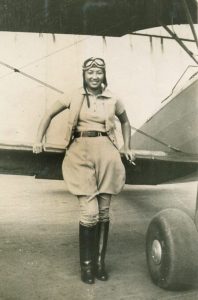Born on August 12, 1912, Hazel Ying Lee (Hazel Yueying Li) grew up in Portland, Oregon. Flying captured her imagination as a teenager. To pay for flying lessons, she took a job as an elevator operator at Liebes Department Store in downtown Portland. This enabled her to enroll in the Al Greenwood Flying School with sponsorship by the Portland Chinese Benevolent Society. Barely nineteen, she became one of the first Chinese American women to earn a pilot license.
Hazel Lee and the Chinese Air Force
As war loomed in China, Hazel Lee joined a squadron of volunteers training in Portland. There, she met her future husband, Clifford Yin Cheung Louie. Along with a group of Chinese Americans hoping to enlist in the Chinese Air Force, Hazel and Clifford traveled to Shanghai. She possessed flying qualifications equal to those of the Chinese American men of her graduating class and felt optimistic about her chances to fly for China. The drafting board, however, refused her persistent appeals to join their Air Force. Reassigned to a desk job at the aeronautical library, Hazel flew occasionally for a commercial operation out of Nanjing. She was in Guangzhou when the Japanese bombed the city in 1937. As a result, she left for Hong Kong as a war refugee. A year later, Hazel returned to the United States.
The Women’s Air Force Service Pilots
In 1942, Hazel applied for the Women’s Flying Training Detachment, later to be known as the Women’s Air Force Service Pilots (WASP). She became the first of two Chinese women to enlist in the organization. Her six-month training took place in Sweetwater, Texas. Following her graduation, Hazel transferred to the Air Transport Command’s 3rd Ferrying Squadron at Romulus Army Air Base in Michigan. She made ferry and administrative flights in Stearman PT-17s, North American T-6 Texans, and the Boeing C-47. In 1944, Hazel attended the Pursuit School in Brownsville, Texas. There, she became one of a select group of women qualified to fly high-powered, fighter aircraft, including the P-51 Mustang.
A Tragic Ending for Hazel Lee
Tragedy struck on November 23, 1944. According to the National WWII Museum, Hazel received orders to pick up a P-63 Kingcobra from the Bell Aircraft factory in Niagara Falls, New York, and fly it to Great Falls, Montana. Great Falls was a major staging area for aircraft on their way to the Soviet Union. After weather delays, Hazel made an approach to landing when things went terribly wrong. Another P-63 also prepared to land – without a working radio. Its pilot Jeff Russel relied on one of the crew to alert the tower of their inability to make contact via radio. With numerous aircraft of the same type circling the field waiting to land, the personnel in the control tower lost track of which aircraft was without a radio.
As Hazel began a long, slow approach to the runway. Russell, positioned above her, duplicated the approach to the field. When the control tower operator noticed the two aircraft too close, he yelled, “pull up!” not remembering which pilot did not have a radio. Hazel heard the order. Russell did not. She pulled her aircraft up and, with no time to react and correct, hit Russell’s plane. Both aircraft crashed at the end of the runway, bursting into flames. Pilots on the ground ran over to the wreck, pulling Russell out. Hazel, trapped in her aircraft, received severe burns. She died two days later, becoming the 38th and final WASP to die in the line of duty. She was 32 years old.
Those who knew Hazel Ying Lee described her as courageous, humorous and enthusiastic about flying. She possessed visions of defeating the enemy as a pilot. Despite rejection by the Chinese military, Hazel found a role supporting the American war effort. She broke boundaries and made history as a Chinese American pilot during World War II. She survived long working hours and racial stereotyping, ultimately giving her life to follow her dream.

